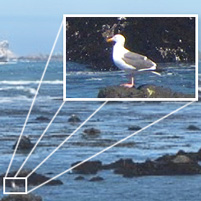Gigapixel Conference

Imagine a panoramic image of dozens of elephant seals on a California beach. Now imagine being able to zoom in with amazing detail on each animal.
Thanks to gigapixel imaging, this type of exploration is not just possible, it's a reality. (Check out National Geographic's "Billion-Pixel Image Tool Probes Science Mysteries")
To discuss its potential use in science research and education, more than 200 scientists, educators and students converged on Carnegie Mellon University for the Fine Conference on Gigapixel Imaging for Science.
"Gigapixel imaging technologies offer the unprecedented ability to capture panoramas at extremely high resolution in a single data file that can be explored interactively with a computer," said Carnegie Mellon Professor Illah Nourbakhsh, who is general co-chair of the conference.
GigaPan technology, developed at Carnegie Mellon's in collaboration with NASA and supported by Google, is revolutionizing the way we think about photography.
This month's Science magazine tracks the evolution of the GigaPan and tallies the sheer number of photographs now hosted on the site: 40,000 public panoramas drawing 20 million visitors a year, with another 20,000 in private areas as contributors work on them.
"As more scientists have exercised their creativity with these technologies, we've come to appreciate that not all panoramas need to record large expanses," he added. "They also can cover microscopic terrain and sometimes even bridge time."
Vertebrate paleontologists, for instance, are using gigapixel imaging not only to capture the quarries where fossils were discovered but of the fossils themselves.
A biologist in Ontario used the GigaPan camera system to monitor a year in the life of a woodlot within an expanding urban area.
And entomologists searching for clues to the Colony Collapse Disorder plaguing bees used GigaPan to watch 3,200 cells in a hive breeding frame over a period of 12 days.
The conference will allow these researchers, and others, to present their findings and brainstorm new possibilities.
Alan Eustace, Google Inc. senior vice president for engineering, Pete Worden, director of NASA's Ames Research Center, and Mark Bauman, executive vice president of National Geographic Television, presented keynote addresses at the inaugural conference.
"We're still early in the evolution of this technology, but we hope that this conference will help us identify those areas where gigapixel imaging holds the most potential, whether as a research tool, an educational device or as a means of engaging the public at large," said Randy Sargent, a scientist at Carnegie Mellon and the NASA Ames Research Center who is a general co-chair of the Fine Conference.
The conference was sponsored by the Fine Foundation of Pittsburgh, which for several years has sponsored workshops to teach scientists from a range of disciplines how to use gigapixel imaging.
Today, more than 100 Fine Fellows in such fields as geology, Egyptology, oceanography, plant biology and climatology are using the technology in their research and educational activities.
In addition to the Fine Foundation, support for the conference has been provided by Intel Corp.
Fine Fellow Ron Schott’s elephant seal panorama was recently featured on the National Geographic website.Related Links: Conference Website | Gigapixel.org | National Geographic Article
